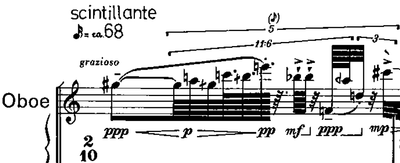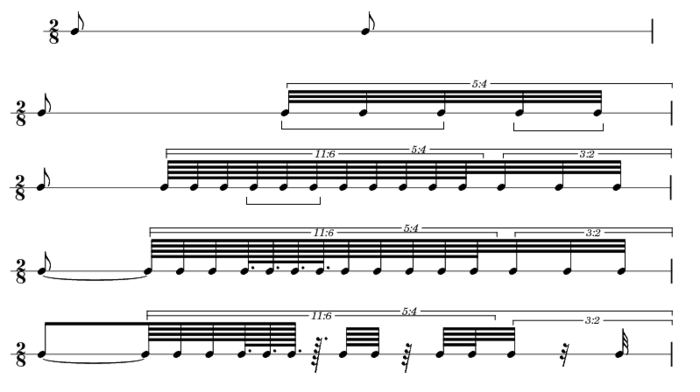
Etudes Transcendantales
Encyclopedia
Etudes Transcendantales is a song cycle
in 9 movements
for mezzo-soprano
and chamber ensemble composed by Brian Ferneyhough
between 1982 and 1985.
, he replaced the clarinet
exchanged for an oboe
, the piano
for a harpsichord
, and removed the violin
altogether. Including the voice, now all the parts are very different from each other and have strongly contrasting timbres, e.g., the pointillistic harpsichord with the smoother mezzo-soprano.
Originally, Ferneyhough intended all the songs to be set to poems by the German poet Ernst Meister. However, he could not find enough suitable poems on death and permanence, and instead commissioned a poet friend, Alrun Moll, to write texts for the remaining songs.
and other New Complexity
composers, Etudes Transcendantales is infamously difficult to perform and is extremely complicated. Pitch-wise, the notes are freely sampled from all 12 tones and the quarter tone
s in between. Rhythmically, Ferneyhough is known for his nested irregular tuplet
s, and there is no exception here. Almost each individual note also has its own unique dynamics and articulation, including extended techniques such as multiphonic
s on the oboe, glottal stops for the voice, and key-clicking for the flute
.
Throughout the nine songs, the process of composition transitions from a Serialist
-type systematic approach in the first song to an intuitive and free approach by the last song. While Ferneyhough thought this system is important, the practical effects are not discernable to the listener, as his intuitive composition produces music like that produced by his automation methods
 For example, for the oboe part in the first song, the rhythm is almost totally determined by a strict system, with five stages of complexity, each determined by another cycle of numbers:
For example, for the oboe part in the first song, the rhythm is almost totally determined by a strict system, with five stages of complexity, each determined by another cycle of numbers:
Each subsequent song has its own unique system (or intuitive development) for the creation of all aspects of the composition.
Alternatively, if only to prove that the score is self-consistent, the rhythm can be deconstructed. The very first measure can be broken down in increasing complexity (note that the actual meter
is in 2/10, but is really equivalent to a 2/8 measure at 5/4 the speed):

Song cycle
A song cycle is a group of songs designed to be performed in a sequence as a single entity. As a rule, all of the songs are by the same composer and often use words from the same poet or lyricist. Unification can be achieved by a narrative or a persona common to the songs, or even, as in Schumann's...
in 9 movements
Movement (music)
A movement is a self-contained part of a musical composition or musical form. While individual or selected movements from a composition are sometimes performed separately, a performance of the complete work requires all the movements to be performed in succession...
for mezzo-soprano
Mezzo-soprano
A mezzo-soprano is a type of classical female singing voice whose range lies between the soprano and the contralto singing voices, usually extending from the A below middle C to the A two octaves above...
and chamber ensemble composed by Brian Ferneyhough
Brian Ferneyhough
Brian John Peter Ferneyhough is an English composer. His music is characterized by the extensive use of complex rhythmic tuplet notation which features in all his works...
between 1982 and 1985.
Background
The creative basis for the Etudes Transcendantales is Ferneyhough's mild mid-life crisis. He thought about death and what makes music more than just music of the moment, and thus the songs deal with such themes. As part of this, he wanted the ensemble to sound rather harsh. Starting from the standard modernist Pierrot ensemblePierrot ensemble
A Pierrot ensemble is a musical ensemble comprising flute, clarinet, violin, cello and piano, frequently augmented by the addition of a singer or percussionist, and/or by the performers doubling on other woodwind/stringed/keyboard instruments.-History:...
, he replaced the clarinet
Clarinet
The clarinet is a musical instrument of woodwind type. The name derives from adding the suffix -et to the Italian word clarino , as the first clarinets had a strident tone similar to that of a trumpet. The instrument has an approximately cylindrical bore, and uses a single reed...
exchanged for an oboe
Oboe
The oboe is a double reed musical instrument of the woodwind family. In English, prior to 1770, the instrument was called "hautbois" , "hoboy", or "French hoboy". The spelling "oboe" was adopted into English ca...
, the piano
Piano
The piano is a musical instrument played by means of a keyboard. It is one of the most popular instruments in the world. Widely used in classical and jazz music for solo performances, ensemble use, chamber music and accompaniment, the piano is also very popular as an aid to composing and rehearsal...
for a harpsichord
Harpsichord
A harpsichord is a musical instrument played by means of a keyboard. It produces sound by plucking a string when a key is pressed.In the narrow sense, "harpsichord" designates only the large wing-shaped instruments in which the strings are perpendicular to the keyboard...
, and removed the violin
Violin
The violin is a string instrument, usually with four strings tuned in perfect fifths. It is the smallest, highest-pitched member of the violin family of string instruments, which includes the viola and cello....
altogether. Including the voice, now all the parts are very different from each other and have strongly contrasting timbres, e.g., the pointillistic harpsichord with the smoother mezzo-soprano.
Originally, Ferneyhough intended all the songs to be set to poems by the German poet Ernst Meister. However, he could not find enough suitable poems on death and permanence, and instead commissioned a poet friend, Alrun Moll, to write texts for the remaining songs.
Music
Like many other works by FerneyhoughBrian Ferneyhough
Brian John Peter Ferneyhough is an English composer. His music is characterized by the extensive use of complex rhythmic tuplet notation which features in all his works...
and other New Complexity
New Complexity
In music, the New Complexity is a term dating from the 1980s, principally applied to composers seeking a "complex, multi-layered interplay of evolutionary processes occurring simultaneously within every dimension of the musical material" ....
composers, Etudes Transcendantales is infamously difficult to perform and is extremely complicated. Pitch-wise, the notes are freely sampled from all 12 tones and the quarter tone
Quarter tone
A quarter tone , is a pitch halfway between the usual notes of a chromatic scale, an interval about half as wide as a semitone, which is half a whole tone....
s in between. Rhythmically, Ferneyhough is known for his nested irregular tuplet
Tuplet
In music a tuplet is "any rhythm that involves dividing the beat into a different number of equal subdivisions from that usually permitted by the...
s, and there is no exception here. Almost each individual note also has its own unique dynamics and articulation, including extended techniques such as multiphonic
Multiphonic
Multiphonics is an extended technique in instrumental music in which a monophonic instrument is made to produce several notes at once....
s on the oboe, glottal stops for the voice, and key-clicking for the flute
Flute
The flute is a musical instrument of the woodwind family. Unlike woodwind instruments with reeds, a flute is an aerophone or reedless wind instrument that produces its sound from the flow of air across an opening...
.
Throughout the nine songs, the process of composition transitions from a Serialist
Serialism
In music, serialism is a method or technique of composition that uses a series of values to manipulate different musical elements. Serialism began primarily with Arnold Schoenberg's twelve-tone technique, though his contemporaries were also working to establish serialism as one example of...
-type systematic approach in the first song to an intuitive and free approach by the last song. While Ferneyhough thought this system is important, the practical effects are not discernable to the listener, as his intuitive composition produces music like that produced by his automation methods

- dividing each measure into a number of notes
- subdividing chunks of those notes into another layer
- adding dots so that 4 notes fit where 3 did previously
- tie some notes with each other and replace others with rests
- replace two consecutive notes with a triplet in which one beat is a rest
Each subsequent song has its own unique system (or intuitive development) for the creation of all aspects of the composition.
Alternatively, if only to prove that the score is self-consistent, the rhythm can be deconstructed. The very first measure can be broken down in increasing complexity (note that the actual meter
Meter (music)
Meter or metre is a term that music has inherited from the rhythmic element of poetry where it means the number of lines in a verse, the number of syllables in each line and the arrangement of those syllables as long or short, accented or unaccented...
is in 2/10, but is really equivalent to a 2/8 measure at 5/4 the speed):

Further reading
- Chapman, Jane (2001). "An Interview with Brian Ferneyhough: Thoughts on the Harpsichord in Etudes Transcendentales". Contemporary Music Review 20 (1), 101–106.

